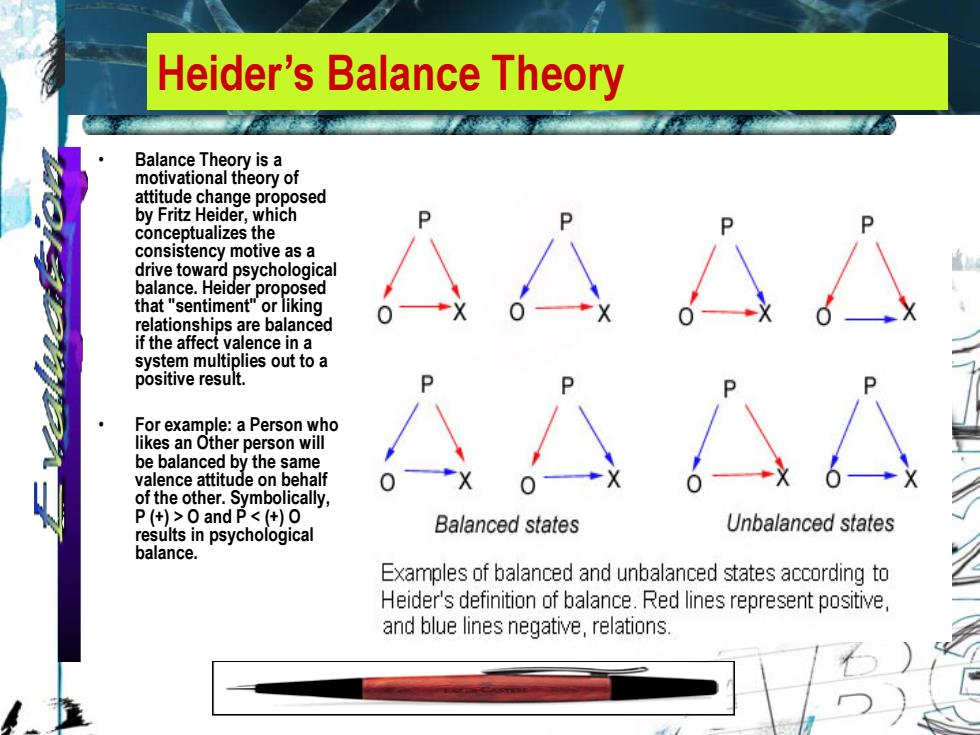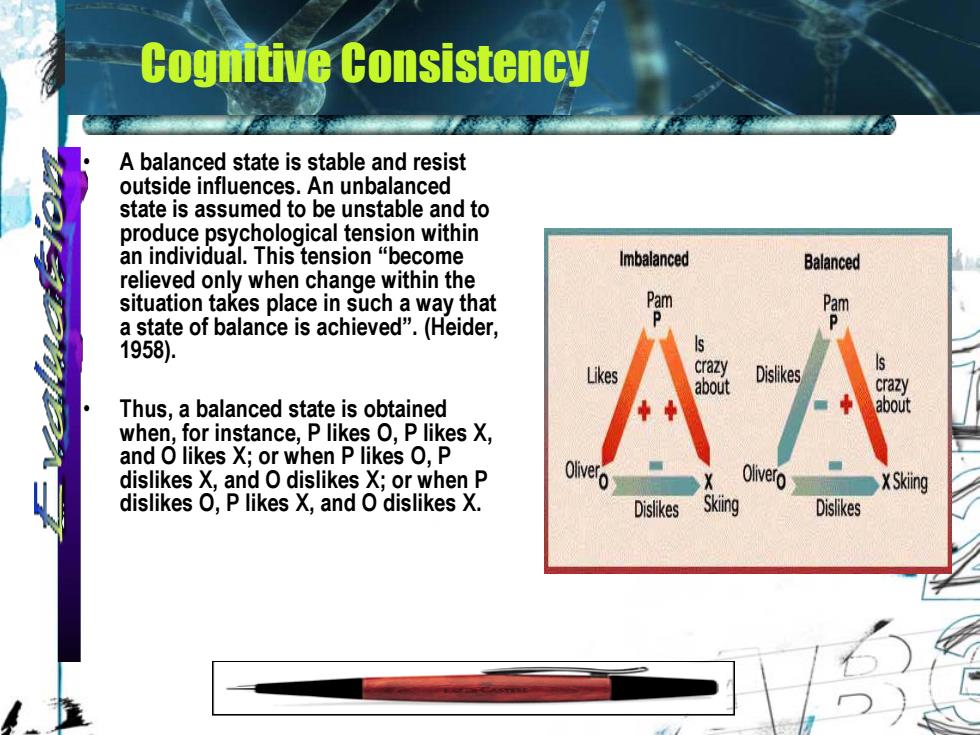
Heider's Balance Theory Balance Theory is a motivational theory of attitude change proposed by Fritz Heider,which 0 conceptualizes the consistency motive as a drive toward psychological balance.Heider proposed that "sentiment"or liking relationships are balanced if the affect valence in a system multiplies out to a positive result. p For example:a Person who likes an Other person will be balanced by the same valence attitude on behalf of the other.Symbolically. P (+)>O andP<(+)O Unbalanced states results in psychological Balanced states balance. Examples of balanced and unbalanced states according to Heider's definition of balance.Red lines represent positive, and blue lines negative,relations
Your Topic Goes Here • Balance Theory is a motivational theory of attitude change proposed by Fritz Heider, which conceptualizes the consistency motive as a drive toward psychological balance. Heider proposed that "sentiment" or liking relationships are balanced if the affect valence in a system multiplies out to a positive result. • For example: a Person who likes an Other person will be balanced by the same valence attitude on behalf of the other. Symbolically, P (+) > O and P < (+) O results in psychological balance. Heider’s Balance Theory

Cogmitive Consistency A balanced state is stable and resist outside influences.An unbalanced state is assumed to be unstable and to produce psychological tension within an individual.This tension "become Imbalanced Balanced relieved only when change within the situation takes place in such a way that Pam Pam a state of balance is achieved".(Heider, 1958). crazy Likes Dislikes about crazy Thus,a balanced state is obtained about when,for instance,P likes O,P likes X, and O likes X;or when P likes O,P dislikes X,and O dislikes X;or when P Olivero XSking dislikes O,P likes X,and O dislikes X. Dislikes Sking Dislikes
Your Topic Goes Here • A balanced state is stable and resist outside influences. An unbalanced state is assumed to be unstable and to produce psychological tension within an individual. This tension “become relieved only when change within the situation takes place in such a way that a state of balance is achieved”. (Heider, 1958). • Thus, a balanced state is obtained when, for instance, P likes O, P likes X, and O likes X; or when P likes O, P dislikes X, and O dislikes X; or when P dislikes O, P likes X, and O dislikes X. Cognitive Consistency

Cigarette ads from the Past How the ads construct the consistency? fONSSM co is Soothed Farewell to for the Softest Taste ofall! the ugly cigarette Smoke pretty eve ASIS
Cigarette ads from the Past How the ads construct the consistency?

Cogmitive Consistency Information Attention 著f0at0裤 Observations Awareness thoughts,cognition,emotions,conation,volition Memory Consciousness Mindlessness,Voice of Blame,Controlling, Mindfulness,Autonomy,Integration,Child Like Negative Voice of Judgment,Self Observations,Meditation,Relatedness,Intrinsic Deprecating,Pain,Hatred,Envy,Desire for motivations Power,Greed,Contempt,Stonewalling, Self-Deception,Extrinsic Motivations Self Determination,Healthy Curiosity, Competency,Skills,Creativity,Self-Esteem, Inspired,More Choices,Enjoyment of Tasks,More Apathy,Boredom,Anxiety Defined Goals,Improved Information Gathering or Heightened Awareness,Doing It Because It Is Depression,Numbness,Dimming Interesting,Achievement Oriented,Spiritual Life, Awareness,Delusions Compassion,inguisitiveness
Your Topic Goes Here • Your Subtopics Go Here Cognitive Consistency

Newcomb Symmetry Theory "Every man is like the company he is wont to keep.” ------(Greek)Euripides Today we say ,"Birds od a feather flock together'”. Newcomb,in contrast to Heider, stresses communication.The less the symmetry between A and B about X,the more probable that A will communicate with B regarding X.symmetry predicts that people associate with or become friends of people with whom they agree
Newcomb Symmetry Theory • “Every man is like the company he is wont to keep.” ------(Greek) Euripides Today we say ,”Birds od a feather flock together”. • Newcomb, in contrast to Heider, stresses communication. The less the symmetry between A and B about X, the more probable that A will communicate with B regarding X. symmetry predicts that people associate with or become friends of people with whom they agree